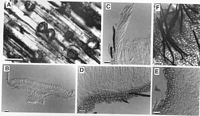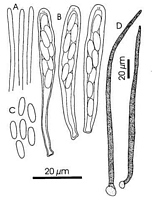|
 Pirottaea palmicola Pirottaea palmicola
BiostatusPresent in region - Indigenous. Endemic
Images (click to enlarge)
Caption: Fig.7 Pirottaea palmicola (A-E, PDD 60281; F, PDD65971): A, apothecia; B, apothecium in
vertical section; C, upper margin of apothecium in vertical section; D, side of apothecium in
vertical se | 
Caption: Fig.8 Pirottaea palmicola (A-C, PDD 60281; D, PDD 60277): A, apex of paraphyses; B,
asci; C, ascospores; D, setae in surface view. | 
Owner: P.R. Johnston |
Article: Johnston, P.R. (1998). Four new Pirottaea species from New Zealand. New Zealand Journal of Botany 36(4): 645-652 (http://www.rsnz.org/publish/abstracts.php).
Description: Apothecia developing on partly decomposed, fallen fronds of Rhopalostylis sapida (Arecaceae). Apothecia 0.5-0.8 mm diam., cup-shaped, more or less urceolate when immature and when dried, substipitate, the receptacle pale brown to brown, with numerous black, stiff setae. Hymenium white when fresh, drying pale yellow.
Ectal excipulum 30-40 µm thick on sides of receptacle in vertical section, comprising 3 or 4 rows of globose cells 8-15 µm diam., with thin, brown walls. Excipular cells at margin of disc extend into hair-like elements 2-4 µm diam., with thin, brown to pale brown walls. Setae arising from cells of excipulum on sides of receptacle, and from amongst hair-like elements at margin of disc. Setae (80-)100-200 x 5-6 µm, with thick, dark brown, smooth walls, cylindric, tapering near apex to more or less acute tip, 3 or 4-septate, although septa often difficult to see. Medullary excipulum 15-20 µm wide at sides of receptacle, comprising cylindric cells 2-4 µm diam., with hyaline, thickened, slightly gelatinised walls. Medullary cells more or less parallel at sides of receptacle, forming textura intricata near base of receptacle and within stipe. Medullary layer dextrinoid in Melter's reagent.
Paraphyses 2 µm diam., cylindric, undifferentiated at apex, about same length as the asci. Asci 55-70(-75) x 6-7 µm, more or less cylindric, apex rounded to subtruncate, wall thickened at apex with small, intensely amyloid ring, 8-spored. Ascospores 8.5-9.5 x 2.5-3 µm, oblong, straight, ends rounded, 0-septate, hyaline.
Cultures approximately 70 mm diam. after 4 weeks on both OA and CMD. Growth
thin, with sparse, cottony, white aerial mycelium. Irregular patches of purplish pigment
evident in some cultures on OA. Cultures remained sterile.
Notes: ETYMOLOGY: refers to the host substrate.
NOTES: P. palmicola is morphologically similar to P. horoeka, but is distinguished by its very
long, more or less straight setae as well as by host substrate. Although known from relatively
few collections, this fungus appears to be common on fallen fronds of Rhopalostylis and
probably occurs throughout the range of its host.
|